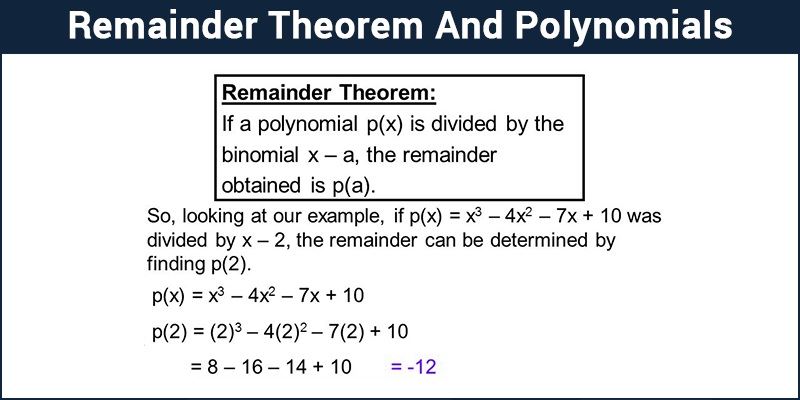Remainder Theorem
Remainder Theorem is an approach of Euclidean division of polynomials. It is also termed as little Bézout’s theorem. According to this theorem, if we divide a polynomial P(x) by a factor ( x – a); that isn’t essentially an element of the polynomial; you will find a smaller polynomial along with a remainder. This remainder that has been obtained is actually a value of P(x) at x = a, specifically P(a). So basically, x -a is the divisor pf P(x) if and only if P(a) = 0. It is applied to factorise polynomials of each degree in a swift and elegant manner.
For example: if f(a) = a3-12a2-42 is divided by (a-3) then the quotient will be a2-9a-27 and the remainder is -123.
if we put, a-3 = 0
then a = 0
Hence, f(a) = f(3) = -123
Thus, it satisfies the remainder theorem.

Remainder Theorem Definition
The Remainder Theorem begins with a polynomial say p(x), where “p(x)” is some polynomial p whose variable is x. Then as per theorem, dividing that polynomial p(x) by some linear factor x – a, where a is just some number. Here we go through long polynomial division, which results in some polynomial q(x) (the “q” stands for “the quotient polynomial”) and a polynomial remainder r(x). It can be expressed as:
p(x)/x-a = q(x) + r(x)
Factor Theorem
Factor theorem is generally applied to factorizing and finding the roots of polynomial equations. It is the reversal form of the remainder theorem. Problems are solved based on the application of synthetic division and then to check for a zero remainder.
When p(x) = 0 then y-x is a factor of the polynomial Or if we consider the other way, then When y-x is a factor of the polynomial then p(x) =0
Remainder Theorem Proof
Theorem functions on an actual case that a polynomial is comprehensively dividable, at least one time by its factor in order to get a smaller polynomial and ‘a’ remainder of zero. This acts as one of the simplest ways to determine whether the value ‘a’ is a root of the polynomial P(x).
That is when we divide p(x) by x-a we obtain
p(x) = (x-a)·q(x) + r(x),
as we know that Dividend = (Divisor × Quotient) + Remainder
But if r(x) is simply the constant r (remember when we divide by (x-a) the remainder is a constant)…. so we obtain the following solution, i.e
p(x) = (x-a)·q(x) + r
Observe what happens when we have x equal to a:
p(a) = (a-a)·q(a) + r
p(a) = (0)·q(a) + r
p(a) = r
Hence, proved.
Steps to Divide a Polynomial by a Non-Zero Polynomial
- First, arrange the polynomials (dividend and divisor) in the decreasing order of its degree
- Divide the first term of the dividend by the first term of the divisor to produce the first term of the quotient
- Multiply the divisor by the first term of the quotient and subtract this product from the dividend, to get the remainder.
- This remainder is the dividend now and divisor will remain same
- Again repeat from the first step, until the degree of the new dividend is less than the degree of the divisor.
Remainder Theorem Problems
Consider the following example:-
Example- Determine that x = 1 is a root of P(x),
Explanation:
It suggests that x = 1 may be a root of P(x), and (x – 1) may be a factor of P(x)
Then if we tend to divide synthetically from P(x) by (x – 1), we will get a new smaller polynomial and a remainder of zero:
| Example: Find the root of the polynomial
Solution:
So, (x-4) must be a factor of
Example: Find the remainder when
Solution: Here,
∴ p (1) = (1)3 – 2(1)2 + 1 + 1= 2
By the Remainder Theorem, 2 is the remainder when
|
Euler Remainder Theorem
Euler’s theorem states that if n and X are two co-prime positive integers, then
Xφ(n) = 1 (mod n)
Xφ(n) = 1 (mod n)
where, φ(n) is Euler’s function or Euler’s totient function, which is equal to;
φ(n) = n (1-1/a).(1-1/b).(1-1/c)
where, n is a natural number, such that n = ap. bq . cr,
here, a, b, c are prime factors of n and p, q, r are positive integers.
| Example: Find the Euler totient function of 35.
Solution: The factors of 35 are as follows:
Thus the totient function of 35 is 24.
|
Questions of the form: man
| Example: Find the remainder when
Solution: Here m = 3, a = 76 and n = 35,
In an example above we have already found the totient function of 35, which is equal to 24.
Remainder of
Remaining power is 4, which when divided by 35 given the resultant remainder.
which is,
Thus the remainder comes out to be 11.
|
This was all about the remainder theorem.
Comments
Post a Comment
Thank You For Visit To My Blog ...
you will soon get the reply.. for your comment.......